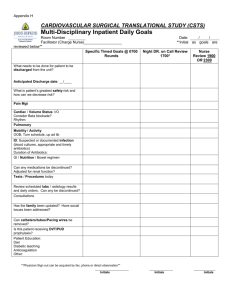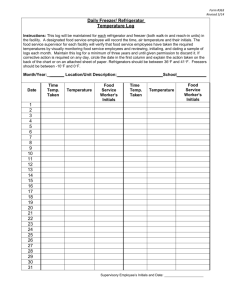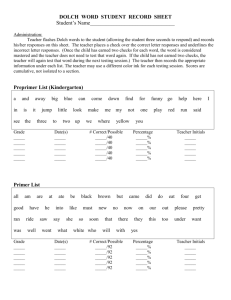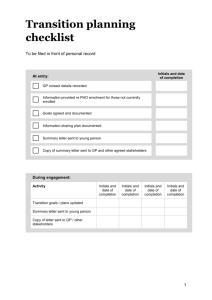Initials: ___________ Name: ____________________________________________
advertisement
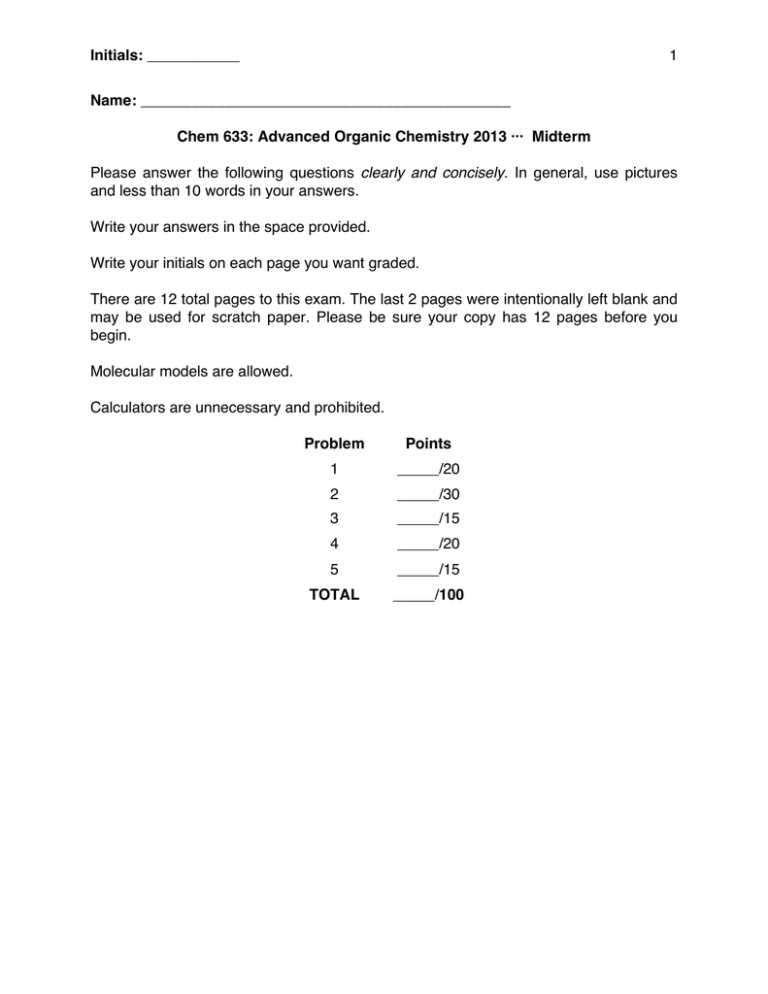
Initials: ___________ 1 Name: ____________________________________________ Chem 633: Advanced Organic Chemistry 2013 ··· Midterm Please answer the following questions clearly and concisely. In general, use pictures and less than 10 words in your answers. Write your answers in the space provided. Write your initials on each page you want graded. There are 12 total pages to this exam. The last 2 pages were intentionally left blank and may be used for scratch paper. Please be sure your copy has 12 pages before you begin. Molecular models are allowed. Calculators are unnecessary and prohibited. Problem Points 1 _____/20 2 _____/30 3 _____/15 4 _____/20 5 _____/15 TOTAL _____/100 Initials: ___________ 2 1. (20 points) Please explain the following observations. (Use pictures and few words.) (a) The pKa of 1a and 2a are the same, but the pKa of 1b is much lower than that of 2b. OH 1a, X = CN 1b, X = NO2 OH H3C X CH3 2a, X = CN 2b, X = NO2 X (b) The gauche conformation of the following molecule is favored over the anti conformation. Me O anti O Me Me O O Me gauche Initials: ___________ 3 (1 – continued) (c) The more stable conformation of this tetraaza-cyclohexane has the methyls arranged as shown in 3b. Me Me Me N N N N Me Me Me Me N N N N Me 3a 3b favored (d) The following equilibrium lies to the right. Me Ph N N Cl Ph Me Cl >99% at equilibrium Initials: ___________ 4 2. (30 points) The reaction of carbene 1 and aldehyde A leads to epoxide 2. This reaction is rapid and reversible. MesN O NMes O O Me Me 1 O + H MesN R Aa, R = p-(NO2)C6H4 Ab, R = t-Bu R NMes O O Me Me 2a, R = p-(NO2)C6H4 2b, R = t-Bu (a) The reaction of aldehyde Aa leads to quantitative conversion of the starting materials to the product. Estimate Keq and ΔG° for this reaction. Initials: ___________ 5 (2 – continued) (b) The reaction of aldehyde Ab proceeds to less than 85% conversion. To study this reaction, researchers performed experiments and obtained the following data. Please show how you would determine ΔG° from this data. (Note: You do not need to calculate ΔG°. Just show the equations and how you would plug in the numbers.) Initials: ___________ 6 (2 – continued) (c) Researchers also wanted to determine ΔG‡, but the reaction was too fast. Instead, they studied the rate of exchange of aldehyde with epoxide 2a. For these experiments, they used a labeled aldehyde Aa* (labeled at H*) and observed the decay of [Aa*] and growth of [2a*]. They hypothesize that this exchange reaction proceeds via 1. NO2 NO2 H* O O MesN O NMes + H* MesN NO2 O Me Me 2a O Step 1 O O Me Me What do the following data tell you? kobs (s–1) 4.0 ± 0.6 4.4 ± 0.5 4.3 ± 0.4 (d) What do the following data tell you? ΔH‡ = 23.9 ±1.9 kcal/mol ΔS‡ = 8 ± 5 cal/mol·K + H NO2 O NMes 1 Equiv of Aa* 4 2 1 NMes Me Me 2a* Aa* MesN Entry 1 2 3 O O Step 2 Aa Initials: ___________ (2 – continued) (e) Based on the above data, which step is rate determining (Step 1 or Step 2)? (f) Please draw a reaction coordinate diagram for the exchange reaction. 7 Initials: ___________ 8 3. (15 points) Hydroxyl groups (OH) can be used to direct epoxidations with m-CPBA, as shown in transition state A below. The epoxidation step is irreversible. O Ph O OH N 1 Ph H R O (m-CPBA, R = m-ClC6H4) O N O O H O A transition state Ph Ph O H O R O OH N O N O O B intermediate 2 OH (a) Please explain the observed stereochemistry of intermediate B. In other words, why is the epoxide “up”? Include clear, 3-dimensional depictions of transition state A in your answer. (b) Draw a reasonable arrow-pushing mechanism for the transformation of intermediate B to product 2 that is consistent with the observed stereochemistry of product 2. Initials: ___________ 9 4. (20 points) The identity of R has a large effect on the rate of the rearrangement shown below. When R = t-Bu, the reaction is 370 times faster than when R = H. O HO R R 1 CF3 substituent R=H R = t-Bu R R R A relative rate 1 370 R 2 (a) Please explain this rate difference. (b) Please draw a reasonable arrow-pushing mechanism for the conversion of intermediate A to 2. For each step, please name the HOMO-LUMO interaction(s). You do not need to draw the HOMO or LUMO. Initials: ___________ 10 5. (15 points) Please draw a reasonable arrow-pushing mechanism for the following reaction (Grossman, Chapter 2, #2h). O O Ph O + H3C H3C N H CO2H ONa O Ph N O O H3C O CH3 O CH3 Initials: ___________ 11 This page has intentionally been left blank, so that you may use it for scratch paper. Initials: ___________ 12 This page has intentionally been left blank, so that you may use it for scratch paper.



